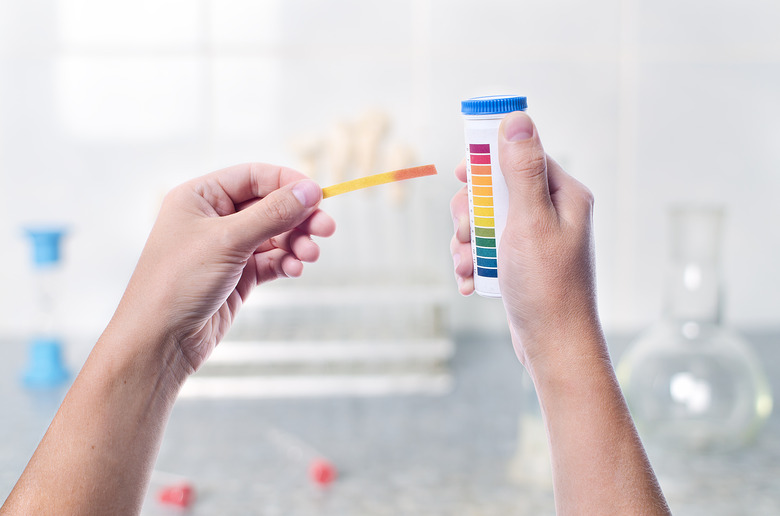How To Calculate The pH Of A Two-Chemical Mixture
The pH value of a solution is used to measure how acidic or basic that particular solution is, rated according to the established pH scale (which runs from zero to 14). Calculated by using the concentration of hydronium, or hydrogen ions, in the solution, it is relatively easy to determine the pH value of a solution containing only a single base or acid. Determining the pH value of a mixed solution, on the other hand – whether it is composed of two bases or two acids – is a slightly more involved task. Luckily, the process isn't as complicated as it first appears.
TL;DR (Too Long; Didn't Read)
Because mixing acids and bases results in a neutralization reaction that forms salt and water, most simple two-chemical solution problems will involve either two bases or two acids. To calculate the pH value of these solutions, first find the concentration and volume of the component chemicals. With the volume of the mixed solution measured, calculate the concentration of hydronium in the solution by dividing the _total_ concentration of hydrogen ions in the solution by the total volume of the mixed solution. The result is the -log of the solution's pH value. Remember to wear appropriate protective gear and be careful, when dealing with and _especially_ when mixing strongly acidic or basic chemicals.
Understanding pH
Understanding
pH
A solution's pH value measures the concentration of hydrogen ions in a given solution. Liquids are not the only solutions that carry pH values: the pH of water is commonly tested for, but the pH value of soil is just as important to track – because in the same way that the pH of water can enrich or inhibit fish living in it, the pH of soil can be used to determine how well certain plants can survive in a given areas. pH is a logarithm of concentration, measured in moles: If you can find the concentration of a given substance, calculating pH is as simple as pressing the "-log" button on a calculator.
Component Calculations
Component
Calculations
The process of calculating pH works the same whether the solution involves two acids or two bases – mixing acids and bases results in a neutralization reaction and the formation of salt (and occasionally water), complicating the calculation of pH values. However, before you can calculate the pH of a two-chemical solution, you will first need information from the solution's components. Find the volume of the component chemicals, as well as the concentration of the molecules in each component solution – with this information noted, the pH of the mixed solution can easily be calculated.
Mixed Solutions
Mixed
Solutions
When two acids or two bases are mixed, the pH of that solution is derived from the average concentrations of hydronium provided to the solution by its component chemicals. In other words, you can calculate the concentration of hydronium in the solution by dividing the total concentration of hydrogen ions in the solution by the total volume of the mixed solution. The result is the -log of the solution's pH value. For example, if the components of a two-acid solution provide 0.025 and 0.015 mol of hydrogen ions (H+), respectively, and the mixed solution has a volume of 200 ml, the concentration will be 0.040 mol divided by 200 ml – or 0.0002 mol of H+. The -log of this concentration, and the pH, would then be 3.699.
References
- RoomF203: pH of Two Mixed Solutions
- Harold Walden: Calculating pH of Resulting Solution
- Purdue University: pH, pOH, pKa, and pKb
- Chemistry LibreTexts: Determining and Calculating pH
- Garg University: How to Calculate pH of Solutions
- Clackamas Community College: Calculating pH and pOH
- Georgia State University HyperPhysics: Acid-Base Reactions
- University of California: What Is pH and Why Do We Care?
- ThoughtCo: pH, pKa, Ka, pKb, and Kb Explained
- Chemistry LibreTexts: The Hydronium Ion
Cite This Article
MLA
Flournoy, Blake. "How To Calculate The pH Of A Two-Chemical Mixture" sciencing.com, https://www.sciencing.com/calculate-ph-twochemical-mixture-8509527/. 15 June 2018.
APA
Flournoy, Blake. (2018, June 15). How To Calculate The pH Of A Two-Chemical Mixture. sciencing.com. Retrieved from https://www.sciencing.com/calculate-ph-twochemical-mixture-8509527/
Chicago
Flournoy, Blake. How To Calculate The pH Of A Two-Chemical Mixture last modified March 24, 2022. https://www.sciencing.com/calculate-ph-twochemical-mixture-8509527/
